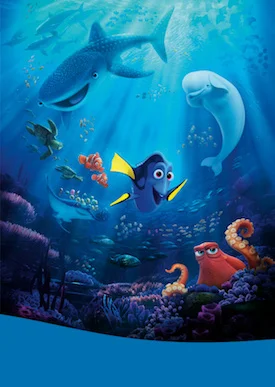Andrew Stanton and Angus MacLane's FINDING DORY
Movie review by Dennis D. McDonald
In some ways Finding Dory is a "textbook" Pixar movie. Strong family oriented story. Emotional loss and gain. Gorgeous images. Humor. Memorable characters beautifully animated. Spectacular action set pieces.
In other words, it's a superb film. I laughed and smiled throughout the film at the clever script and the remarkable creativity on display.
Having read Ed Catmull's book about how they take years to develop films at Pixar I appreciate the amazing talent and work that goes into making a film like this. You can tell that everything has been worked, reworked, and reworked again to very high shine. As with other Pixar movies, though, it's not just the quality, images, and humor on display here that makes it so enjoyable, it's the positive view of the characters and their relationships that wins the day.
Nothing illustrates this better than to compare Finding Dory with the other animated children's films being previewed in theaters at the same time. They may also feature anthropomorphosized animals, but there is a coarseness and "cheap laughs" element to them that, while it may appeal to kids, may also quickly fade them into obscurity.
That's not the case with Finding Dory. There's an underlying sweetness and emotional core here that's very hard to resist. I certainly couldn't.
That's not to say that there is not a serious element to Finding Dory. There certainly is. Most of the action takes place at the fictional seaside "Marine Life Institute" where Dory, Marvin, and Nemo travel to find Dory's parents.
It's a bizarre but realistic facility. Perched on the ocean it reproduces the most colorful features of the ocean for public access and display and even sports a "petting zoo" where little kids can reach down into the water and touch mobile and immobile sea creatures (one of the movie's scarier sequences). Behind the scenes (and under the tanks) there are dark and foreboding areas that Dory and her allies must traverse in order to find her parents. These darker places contrast sharply with the color and light of the open ocean and the chrome and plexiglass of the Institute.
The Institute's public address system (via the dulcet tones of an unseen but named Sigourney Weaver) repeatedly describes the Institute's as a place for "rehabilitation and release." We the audience suspect from the start that there may be more going on here than meets the eye but the movie carefully avoids explicit references to the downside of animal captivity in an artificial environment.
But that's the jaded adult in me talking. The dual focus of the film is on family and humor, imaginatively presented. Who would have thought, for example, that the often- and over-used song "What a Wonderful World" as performed by Louis Armstrong would be so effective in illustrating one of the wildest and funniest action sequences ever animated?
Review copyright (c) 2016 by Dennis D. McDonald


